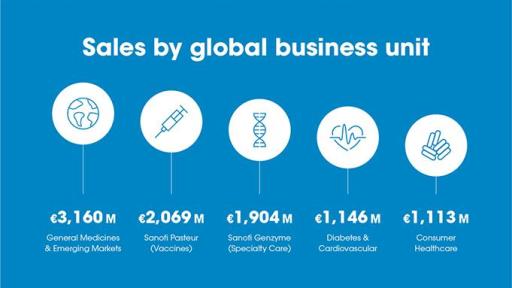
| Media Relations: | Investor Relations: |
|---|---|
| Ashleigh Koss | George Grofik |
| 908-981-8745 | +33 (0)1 53 77 45 45 |
| Email: [email protected] | Email: [email protected] |






Media Panel
Resources
Sanofi Q3 2018 Performance Confirms Return to Growth
Paris, October 31, 2018 — Sanofi (NYSE: SNY; EURONEXT: SAN)
| Q3 2018 | Change | Change at CER | 9M 2018 | Change | Change at CER |
|
| IFRS net sales reported | €9,392m | +3.7% | +6.3% | €25,466m | -3.5% | +2.1% |
| IFRS net income reported | €2,274m | +45.7% | - | €4,052m | -51.1%(2) | - |
| IFRS EPS reported | €1.82 | +46.8% | - | €3.25 | -50.7%(2) | - |
| Business net income(1) | €2,299m | +7.6% | +10.3% | €5,455m | -2.9% | +4.2% |
| Business EPS(1) | €1.84 | +8.2% | +11.2% | €4.37 | -2.0% | +5.2% |
Third-quarter sales(3) growth led by Specialty Care and Vaccines with strong support from Emerging Markets
- Net sales were €9,392 million, an increase of 3.7% on a reported basis, 6.3%(3) at CER and 3.4% at CER/CS (4).
- Sanofi Genzyme sales up 36.1% (14.9% at CER/CS(4)) driven by Immunology and Rare Blood Disorder franchises.
- Vaccines delivered solid growth with sales up 8.2%, supported by the Pentaxim® recovery.
- CHC sales increased 4.1% with growth across all geographies and key categories.
- DCV(5) GBU sales were down 12.1%; Global Diabetes franchise sales declined 9.2%, with non-U.S. sales up 4.7%.
- Emerging Markets sales(6) were up 10.4% supported by Vaccines and strong pharmaceutical growth in China.
Q3 2018 business EPS reflects beginning of new growth period
- Third-quarter 2018 business EPS(1) up 11.2 % at CER to €1.84.
- Third-quarter 2018 IFRS EPS was €1.82 (up 46.8%) reflecting €537 million of net capital gain related to EU generics.
- Business operating income increased 6.4% at CER.
- Business EPS(1) in 2018 now expected to grow 4% to 5% at CER(7) barring unforeseen major adverse events. Currency impact on 2018 Business EPS estimated to be around -6% applying the average October exchange rates.
Key achievements in sustaining innovation in R&D
- Dupixent® approved in the U.S. for treatment of moderate-to-severe asthma.
- Libtayo® approved in the U.S. for treatment of CSCC(8).
- Cablivi® approved for aTTP(9) in EU and priority review granted in the U.S.
- Praluent® ODYSSEY OUTCOMES results accepted for review by the FDA.
- Dupixent® submitted to the FDA and the EMA for treatment of moderate-to-severe atopic dermatitis in adolescents.
Sanofi Chief Executive Officer, Olivier Brandicourt, commented:
“In the third quarter, Sanofi entered a new growth phase. We delivered strong results with double-digit growth in Specialty Care and Emerging Markets, while Vaccines contributed a high-single digit increase in sales. In addition, we are looking forward to expanding our Specialty Care business with the launches of Libtayo®, Cablivi® and Dupixent® for asthma. Based on the underlying dynamics demonstrated in the quarter, Sanofi is now well positioned to deliver growth”.
R&D update
Regulatory update
Regulatory updates since July 31, 2018 include the following:
- In October, the U.S. Food and Drug Administration approved Dupixent® (dupilumab, collaboration with Regeneron) as an add-on maintenance therapy in patients with moderate-to-severe asthma aged 12 years and older with an eosinophilic phenotype or with oral corticosteroid-dependent asthma.
- In October, the European Medicines Agency’s (EMA) Committee for Medicinal Products for Human Use (CHMP) adopted a positive opinion for the marketing authorization of Dengvaxia® (dengue tetravalent vaccine), recommending its approval in Europe.
- In September, Libtayo® (cemiplimab-rwlc, collaboration with Regeneron) was approved in the U.S. for the treatment of patients with metastatic cutaneous squamous cell carcinoma (CSCC) or locally advanced CSCC who are not candidates for curative surgery or curative radiation.
- In September, Sanofi and Regeneron announced that the U.S. Food and Drug Administration (FDA) accepted for review a supplemental Biologics License Application (sBLA) for Praluent® (alirocumab, collaboration with Regeneron). The sBLA outlines a proposed update to the prescribing information to include the effect of Praluent® in reducing the overall risk of major adverse cardiovascular events.
- In September, the European Commission granted marketing authorization for Cablivi® (caplacizumab) for the treatment of adults with acquired thrombotic thrombocytopenic purpura (aTTP). In addition, the FDA accepted for priority review the Biologics License Application for caplacizumab for adults experiencing an episode of aTTP.
- Dupixent® (dupilumab, collaboration with Regeneron) was submitted to the FDA and to the EMA for the treatment of atopic dermatitis for adolescent patients (aged 12-17 years).
At the end of October 2018, the R&D pipeline contained 94 projects including 42 new molecular entities in clinical development. 40 projects are in phase 3 or have been submitted to the regulatory authorities for approval.
Portfolio update
Phase 3:
- In October Sanofi and Regeneron announced that two pivotal Phase 3 placebo-controlled trials evaluating Dupixent® (dupilumab) in adults with inadequately-controlled chronic rhinosinusitis with nasal polyps met all primary and secondary endpoints. Detailed results from these trials will be submitted for presentation at future medical meetings, and will form part of the companies’ regulatory submissions.
- In September, detailed results from a pivotal Phase 3 trial showing Dupixent® (dupilumab) monotherapy demonstrated a significant improvement in signs and symptoms of atopic dermatitis and certain quality of life measures in adolescent patients with moderate-to-severe atopic dermatitis, were presented at the European Academy of Dermatology and Venereology (EADV) Congress.
- The results of the first Phase 3 evaluating MenQuadTT, a quadrivalent meningococcal conjugated vaccine, were presented in September at the International Pathogenic Neisseria Conference. This study demonstrated that MenQuadTT was safe and as immunogenic as Menactra® when administered as a booster dose in adolescents and adults (15 yrs and above) primed with quadrivalent meningococcal conjugated vaccines
- Results from a Phase 3 trial for Fluzone® High-Dose Quadrivalent showed comparable safety and immunogenicity to Fluzone® High-Dose Trivalent. The primary endpoint was to determine if the quadrivalent high-dose vaccine induces an immune response that is non-inferior to that produced by Fluzone® High-Dose Trivalent. The key secondary endpoints were to evaluate the safety of the vaccine and demonstrate that each B strain in the quadrivalent high-dose vaccine induces an immune response that is superior to that produced by the trivalent high-dose vaccine not containing the corresponding B virus type.
- A Phase 3 trial evaluating isatuximab was initiated in newly-diagnosed transplant-eligible multiple myeloma patients (in conjunction with the German Multiple Myeloma Group, GMMG).
- Two Phase 3 trials, evaluating sarilumab (collaboration with Regeneron) for the treatment of Giant Cell arteritis and Polymyalgia Rheumatica, are in the process of being initiated.
- A Phase 3 trial evaluating Dupixent® (dupilumab) in Eosinophilic esophagitis has been initiated.
- Sanofi will not initiate a Phase 3 program to evaluate Lemtrada® in primary progressive multiple sclerosis.
Phase 2:
- A Phase 2 study evaluating the combination of isatuximab and atezolizumab (PD-L1 monoclonal antibody from Roche) was initiated in advanced malignancies.
- A Phase 2 Study of AR101 (collaboration with Aimmune) with adjunctive dupilumab was initiated in peanut-allergic patients (ages 6-17).
- Following the results of the Phase 2b RESPIRE study, Sanofi decided not to pursue further development of ALX0171 (anti RSV Nanobody - Respiratory Syncitial Virus ) in the infant population. While results were positive for the primary endpoint of anti-viral efficacy and target exposure was achieved, consistent clinical efficacy was not observed across secondary endpoints. Sanofi will continue the phase 2 program (BREEZE) in adult patients who have received hematopoietic stem cell transplantation.
Phase 1:
- SAR442720, an SHP2 inhibitor (collaboration with Revolution Medicines), entered Phase 1 in solid tumors.
- SAR440234, a T-cell engaging multi-specific monoclonal antibody, entered Phase 1 for the treatment of leukemia.
To access the full press release of the 2018 Q3 results, please click here.
Forward-Looking Statements
This press release contains forward-looking statements as defined in the Private Securities Litigation Reform Act of 1995, as amended. Forward-looking statements are statements that are not historical facts. These statements include projections and estimates and their underlying assumptions, statements regarding plans, objectives, intentions and expectations with respect to future financial results, events, operations, services, product development and potential, and statements regarding future performance. Forward-looking statements are generally identified by the words “expects”, “anticipates”, “believes”, “intends”, “estimates”, “plans” and similar expressions. Although Sanofi’s management believes that the expectations reflected in such forward-looking statements are reasonable, investors are cautioned that forward-looking information and statements are subject to various risks and uncertainties, many of which are difficult to predict and generally beyond the control of Sanofi, that could cause actual results and developments to differ materially from those expressed in, or implied or projected by, the forward-looking information and statements. These risks and uncertainties include among other things, the uncertainties inherent in research and development, future clinical data and analysis, including post marketing, decisions by regulatory authorities, such as the FDA or the EMA, regarding whether and when to approve any drug, device or biological application that may be filed for any such product candidates as well as their decisions regarding labelling and other matters that could affect the availability or commercial potential of such product candidates, the absence of guarantee that the product candidates if approved will be commercially successful, the future approval and commercial success of therapeutic alternatives, Sanofi’s ability to benefit from external growth opportunities, to complete related transactions, and/or obtain regulatory clearances, risks associated with intellectual property and any related pending or future litigation and the ultimate outcome of such litigation, trends in exchange rates and prevailing interest rates, volatile economic conditions, the impact of cost containment initiatives and subsequent changes thereto, the average number of shares outstanding as well as those discussed or identified in the public filings with the SEC and the AMF made by Sanofi, including those listed under “Risk Factors” and “Cautionary Statement Regarding Forward-Looking Statements” in Sanofi’s annual report on Form 20-F for the year ended December 31, 2017. Other than as required by applicable law, Sanofi does not undertake any obligation to update or revise any forward-looking information or statements.


